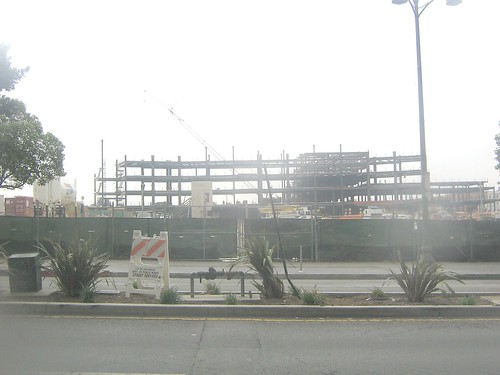
After months of waiting, the skeleton of the new school complex is really rising fast at the Ambassador site. Curbed LA has more on the new Robert F. Kennedy pocket park (which will take up just 1/3 acre off Wilshire) here.

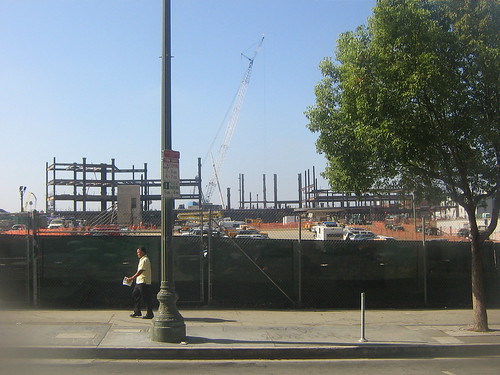
The scope of the project includes a K-3 School, a 4-8 Middle School, and a High School, for a total of 4,624 students. The 92,000-square-foot K-3 building will accommodate 1,150 seats within 46 classrooms on three floors. The school will be located on the Ambassador Hotel site. The 4-8/High School building will accommodate 3,474 seats within 130 classrooms on six floors. The area is 382,000 square feet, and the rehabilitated Cocoanut Grove building is an additional 48,410 square feet of enclosed and covered areas.
The proposed subterranean parking structure will accommodate a total of 442 parking spaces on two levels for faculty and administrative staff. Playfields for the proposed 4-8/HS will be constructed above the parking structure. The scope also includes construction of a gymnasium building. This structure will accommodate the gymnasium court for grades 6-8 and Central Plant equipment on the first floor, and a gymnasium court for grades 9-12 on the upper level. This is one of the first LAUSD schools with an extensive public art program.
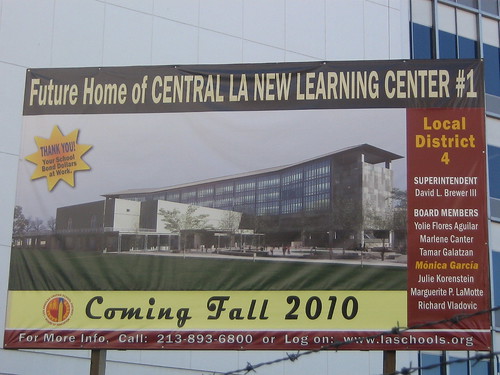
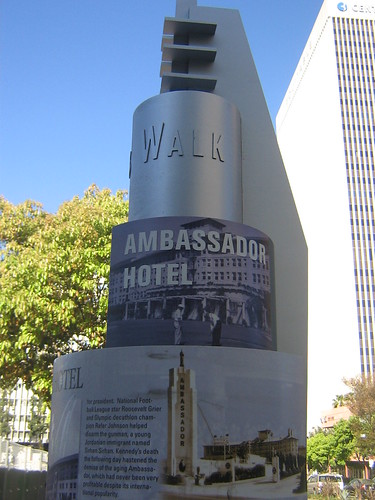




Ending perhaps its most contentious battle over a new campus, the Los Angeles Unified School District will pay $4 million to fund historic school conservation in exchange for the Los Angeles Conservancy dropping a lawsuit that sought to preserve the once-glitzy Cocoanut Grove nightclub at the former Ambassador Hotel.
"We still continue to believe that it was feasible to save the hotel," said Linda Dishman, the conservancy's executive director. "At this point, we as an organization want to move on. What's left at the Ambassador site is not really historic preservation at this point, and there's a lot of other buildings we can focus on."
The settlement will allow the school system to demolish most of the Cocoanut Grove's structure and begin building a sprawling, 4,200-student K-12 campus on the site, which it had been eyeing for a school for decades.
"It is my greatest hope that this puts the whole saga finally to an end," said Kevin Reed, the district's general counsel. He said the district would have won the lawsuit, but decided to end the case so the $566-million project could continue on schedule. The first of the schools, a K-3 building, is slated to open in 2009.

The Los Angeles Conservancy sought to halt the wrecking ball until a judge had time to rule on whether the district was breaking the law by tearing the club down...
In a second, related matter, the conservancy dropped its call for an injunction to bar the district from destroying items collected from the hotel's pantry, the site of the 1968 assassination of U.S. Sen. Robert F. Kennedy.
The district said the matter was moot, as it has no plans to destroy the items, including electrical fixtures.
The district also quietly destroyed the pantry but saved fixtures, sections of the structure, and the ice machine, and 3-D imagery was taken of the room.
Those moves led to the current lawsuit, in which the conservancy alleges that the district hasn't proven that its only option is to tear down and replicate the club and that it improperly handled the pantry. The district said it discovered that the pantry would crumble if it were moved in one piece and that its method of preservation was better.
The "Notice of Preparation, Supplement to Final Environmental Impact Report" reads: The 2004 FEIR included mitigation measures for the adaptive reuse of the Cocoanut Grove as an auditorium subject to structural materials testing. Based upon extensive testing and evaluation by the District's structural engineer, consultants and staff, the District determined that it is technically infeasible to retain and reuse all of the features that were described in the 2004 FEIR due to their age and degraded and unstable condition
In a state-mandated environmental impact report, the district acknowledged that the property was historically significant. To mitigate the impact of tearing most of it down, L.A. Unified said it would preserve the pantry where Robert F. Kennedy was assassinated in 1968 and keep the Cocoanut Grove, turning it into a high school auditorium.
In public statements and during court proceedings, the district said it would cut out the pantry and preserve it whole. Officials said those plans were based on a review of blueprints and visual inspection of the site.
But under current plans, only the east wall, the circular entry and a portion of the glass west wall of the nightclub and historic Paul Williams cafeteria will not be destroyed, along with some interior features that were removed and will be incorporated into the design. As for the pantry, L.A. Unified decided in 2005 that the district would collect 29 items from it -- mostly doors, electrical items and an ice machine -- put them in storage, and tear down the rest of it.
According to a supplemental environmental impact report approved by the board Tuesday, testing found that the concrete connections were inadequate and the cement content and strength of the concrete were too low in most of the Cocoanut Grove.
Shoring the walls would take up so much space that ceilings would be low and hallways too narrow for the area to be functional, said Jim Cowell, the outgoing head of new construction for the district. Instead, the district will tear down the concrete walls and build new ones in the same place, move the stage and slope the floor, so the nightclub can work as an auditorium. The east wing was stronger than the rest of the building, so the structural elements there will be maintained.
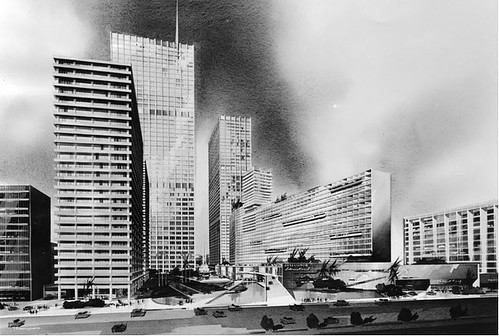
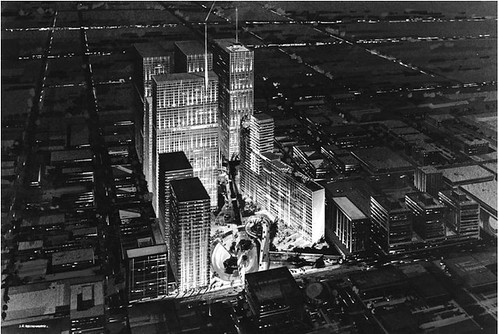
I've been following the dismantling of the Ambassador on your site with great sadness. I worked next door at what was then Tishman Plaza at 3440 Wilshire beginning in 1971. The monthly parking fee there was a bit too steep (when you're starting at $85 a week), but I found a lot just east of the Ambassador, off Catalina where 7th St. dead-ends at the grounds, where parking was only $8 a month. So, every morning, I crossed the grounds and went through the hotel lobby and the little arcade of shops, and out the main entrance to get to my office. That and the walk back
through in the evening were my favorites parts of the day. That parking lot can still be seen (as can the intact hotel itself, bungalows and all) on Google Earth. I rather hope they never get around to updating those images.
Yes, I know; all terribly exciting. But my main purpose here is to share some renderings from 1957 of a project called Ambassador International, which, mercifully, never got off the ground. They serve to illustrate that the LAUSD project which ultimately led to its demise was not the
first threat the Ambassador faced, and I thought you might find them interesting..
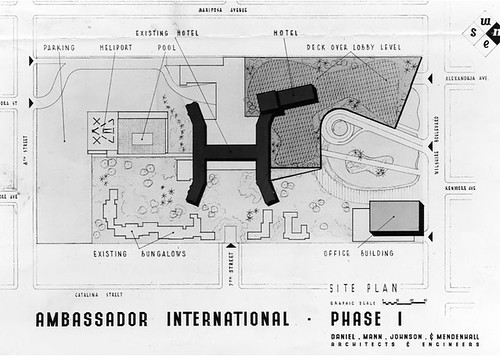
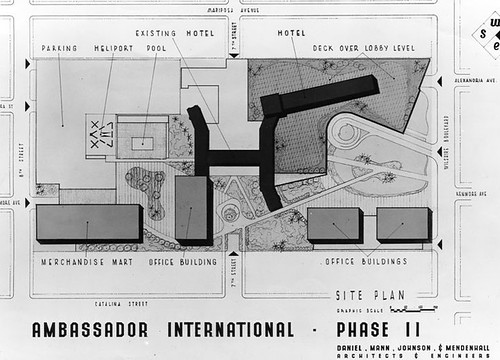
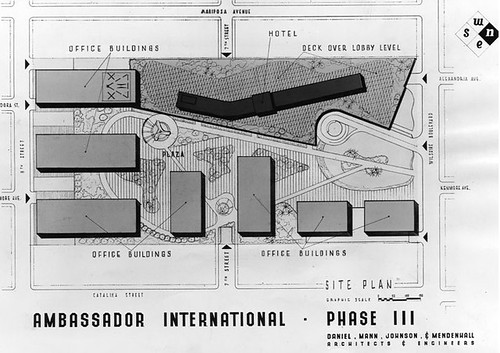
Mike & Maria,
I was driving by the Ambassador tonight & saw a few of these attached to the fence.
It looks like there will be very little, if anything, reused of the Cocoanut Grove.
It does seem that there is the opportunity to give written comment on LAUSD's desire not to have to revise the EIR.
The price tag, estimated at $309 million, has jumped more than 14% in recent months after the discovery of potentially explosive methane gas deposits beneath the site that will require an elaborate mitigation plan. And, unless staggering increases in construction costs that have persisted in Los Angeles abate, the final cost of the school could climb higher, district officials said.
Guests at Monday's ceremony, however, were not talking about money. It was a day of celebration and photo ops replete with golden shovels for tossing dirt. Speakers, including Councilmen Herb Wesson and Jose Huizar, repeatedly praised recently departed Supt. Roy Romer and school board members for shepherding the project forward despite preservation groups who fought to save the historic hotel.
"There could be no better memorial to my father than a living memorial that educates the children of this city," said an emotional Max Kennedy, speaking from a plateau of tightly packed dirt on the 24-acre construction site, overlooking the remains of buildings where Democratic presidential candidate Sen. Robert F. Kennedy was assassinated in 1968.




Today I was contacted by the Oprah Winfrey Show, which is running a show next week on Emilio Estevez’ movie *Bobby*, and asked if I would be willing to let them use my shots of the Ambassador Hotel for credit. I said yes. If they do use any, they will let me know the airdate, and I will let you know.


I've really enjoyed your Ambassador Hotel blog. I live about 10 feet from the hotel property, so I've been very interested in what's happening there, and your site has been a source of much useful info.
Thought you might be interested to know: after a couple months of silence, the bulldozers have been back to work there for the past three days (they showed up on Saturday morning, and continued on Monday and Tuesday). They're not doing anything to the building itself (what's left of it), but they're hard at work digging up portions of the property behind the building.
Does this renewed activity signal anything important? (for example, are they gearing up to start working on the school?) Useful intel has been hard to find.

The two unmarked metal bins sitting in a storage lot in Los Angeles' garment district hold artifacts from one of the most shocking events in modern American history: equipment and fixtures from the pantry where Robert F. Kennedy was fatally wounded June 5, 1968.
The 29 items from the now-demolished Ambassador Hotel, including chandelier lights, wainscoting and the ice machine behind which assassin Sirhan Sirhan may have hid, face an uncertain fate.
Are they really the stuff of history? Do they enhance national memory? And what is to be done with them as school officials prepare to build a campus on the former hotel site?
As with anything connected to assassinations and the Kennedys, answers do not come easily.
Some preservationists contend the collection should be used in a re-creation of the pantry at the school. Some historians want the artifacts given to a museum or library for permanent safekeeping. The Kennedy family wants all of them destroyed and kept out of the hands of ghoulish collectors.
On the morning of June 5, 1998, I purchased two sets of white flowers. I decided to try to put the flowers on the property of the Ambassador Hotel. So from Wilshire Boulevard, I walked up the drive to the parking lot and asked the parking lot attendant, who was at his booth, if I could g on the Ambassador grounds and put my flowers down. To my amazement, the parking lot attendant said to me nicely, "Go ahead."
I walked from the parking lot area to the front of the Cocoanut Grove entrance. I then put one set of white flowers on the lawn and took pictures... I noticed that the front doors of the Cocoanut Grove were open, and I decided to go inside. (You will notice, in my pictures, that there were vans and people were unloading them for making films at the Ambassador. I laid down the second set of white flowers on the floor in the Cocoanut Grove.
I felt lucky enough for this experience, and left the Ambassador grounds without a hassle.
Unsolicited Tribute from a Great American Author
"The Ambassador, with its own gay streets of shops, a theatre and restaurants and the world-famous 'Cocoanut Grove" is believed by some to be only another magnificant hotel, but it's much more... it is a three-ring circus of indoor and outdoor amusements in a layout filled with happy conceptions."
-- Gouverneur Morris
For the past four years I have worked near the site of the famous Ambassador Hotel, beloved Los Angeles landmark. In 2001 the Los Angeles Unified School District bought the site to build a new school, with the plan to demolish the entire historic structure. This prompted a lawsuit by the Los Angeles Conservancy, which was settled in 2005, clearing the way for the demolition of most, but not all, of the structure.
When I learned of the settlement, I began photographing the demolition for posterity. These images will be donated to the Conservancy for use in future preservation efforts. “Don’t let this happen to your historic building,” will be the message. What follow are my favorite of hundreds of images I took for this project, The Death of the Ambassador.
Staffers at the Archdiocese of Los Angeles—in the office building at 3424 Wilshire—just heard a loud crash outside. They ran to the window and saw that a crane had torn the front off the old Cocoanut Grove, the last part of the Ambassador Hotel still standing. An email concludes: "Gee, not much left to preserve now."

The loveliest tribute came from Carlyn Frank Benjamin - daughter of one of the Ambassador's first caretakers, and a 16-year resident of the hotel from the time it opened in 1921: "I'd always hoped the old girl would put on some new clothes and some comfortable shoes and some rose-scented moisturizing lotion, and that she could have had a new lease on life. ..."
And then she conjured the image of the Ambassador's ghosts rising up, filtering up through the debris and inspiring the LAUSD students who will occupy the school soon to be built on the site.
If that can happen, the death of the Ambassador won't have been a huge waste.










